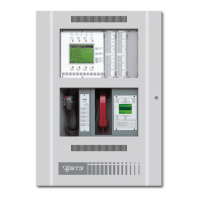System overview
1.4 EST3 Installation and Service Manual
• Copper or fiber network and audio communications
• Application and firmware downloading over the network or
from a single point
• Network-wide control routing
• Form C alarm, supervisory, and trouble relay contacts
Refer to the release notes for the latest information regarding
specifications and capabilities.
Minimum system requirements
NFPA 72 system
classification
Required control equipment
Protected Premises
(Local)
Cabinet with a CPU (Central Processor
module), one LCD (Main LCD Display
module) one 3-PPS/M Primary Power
Supply and Monitor, appropriate
batteries, plus appropriate initiating
device circuits and notification appliance
circuits
Auxiliary
—or—
Remote Station
—or—
Proprietary Protected
Premises
Add a 3-OPS Off Premises Signal
module or a correctly configured and
programmed 3-MODCOM Modem
Communicator module to the protected
premises system
System construction
The EST3 system is assembled in layers as shown in Figure 1-1.
The cabinet (1) houses all the system components. A variety of
cabinets are available for as few as 5 and as many as 21 modules.
A 3-RCC14 cabinet is illustrated in Figure 1-1.
Mounted directly to the cabinets are the rail chassis assemblies
(2), of which there are three types: rail, audio, and audio with
telephone. The most common chassis is the rail chassis, which
provides mounting and electrical connections for the local rail
modules (LRMs) (4). Mounted on the rear of the chassis are the
cabinet power supplies (3).
The local rail modules (4) are the specialized cards that provide
an interface between the CPU and the field wiring. The front of
any rail module can support a control/display module (5),
providing customized operator controls and annunciators.

